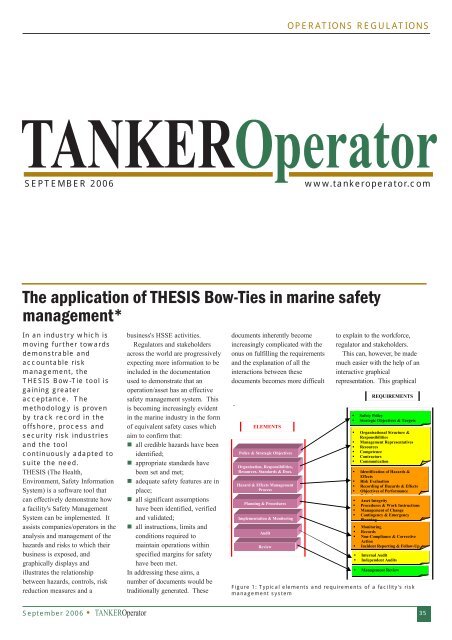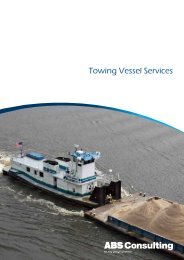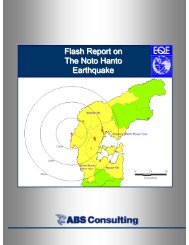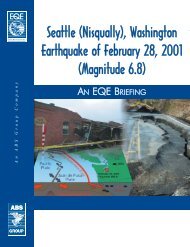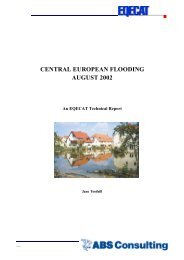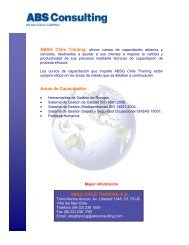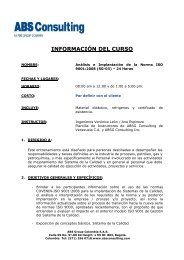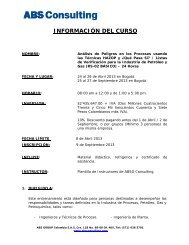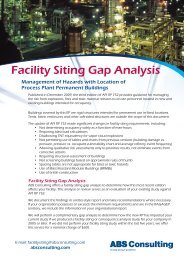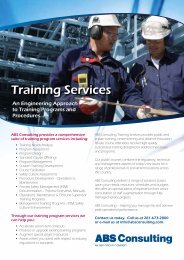The Application of THESIS BowTies in Marine ... - ABS Consulting
The Application of THESIS BowTies in Marine ... - ABS Consulting
The Application of THESIS BowTies in Marine ... - ABS Consulting
You also want an ePaper? Increase the reach of your titles
YUMPU automatically turns print PDFs into web optimized ePapers that Google loves.
OPERATIONS REGULATIONS<br />
TANKEROperator<br />
SEPTEMBER 2006<br />
www.tankeroperator.com<br />
<strong>The</strong> application <strong>of</strong> <strong>THESIS</strong> Bow-Ties <strong>in</strong> mar<strong>in</strong>e safety<br />
management*<br />
In an <strong>in</strong>dustry which is<br />
mov<strong>in</strong>g further towards<br />
demonstrable and<br />
accountable risk<br />
management, the<br />
<strong>THESIS</strong> Bow-Tie tool is<br />
ga<strong>in</strong><strong>in</strong>g greater<br />
acceptance. <strong>The</strong><br />
methodology is proven<br />
by track record <strong>in</strong> the<br />
<strong>of</strong>fshore, process and<br />
security risk <strong>in</strong>dustries<br />
and the tool<br />
cont<strong>in</strong>uously adapted to<br />
suite the need.<br />
<strong>THESIS</strong> (<strong>The</strong> Health,<br />
Environment, Safety Information<br />
System) is a s<strong>of</strong>tware tool that<br />
can effectively demonstrate how<br />
a facility's Safety Management<br />
System can be implemented. It<br />
assists companies/operators <strong>in</strong> the<br />
analysis and management <strong>of</strong> the<br />
hazards and risks to which their<br />
bus<strong>in</strong>ess is exposed, and<br />
graphically displays and<br />
illustrates the relationship<br />
between hazards, controls, risk<br />
reduction measures and a<br />
bus<strong>in</strong>ess's HSSE activities.<br />
Regulators and stakeholders<br />
across the world are progressively<br />
expect<strong>in</strong>g more <strong>in</strong>formation to be<br />
<strong>in</strong>cluded <strong>in</strong> the documentation<br />
used to demonstrate that an<br />
operation/asset has an effective<br />
safety management system. This<br />
is becom<strong>in</strong>g <strong>in</strong>creas<strong>in</strong>gly evident<br />
<strong>in</strong> the mar<strong>in</strong>e <strong>in</strong>dustry <strong>in</strong> the form<br />
<strong>of</strong> equivalent safety cases which<br />
aim to confirm that:<br />
• all credible hazards have been<br />
identified;<br />
• appropriate standards have<br />
been set and met;<br />
• adequate safety features are <strong>in</strong><br />
place;<br />
• all significant assumptions<br />
have been identified, verified<br />
and validated;<br />
• all <strong>in</strong>structions, limits and<br />
conditions required to<br />
ma<strong>in</strong>ta<strong>in</strong> operations with<strong>in</strong><br />
specified marg<strong>in</strong>s for safety<br />
have been met.<br />
In address<strong>in</strong>g these aims, a<br />
number <strong>of</strong> documents would be<br />
traditionally generated. <strong>The</strong>se<br />
documents <strong>in</strong>herently become<br />
<strong>in</strong>creas<strong>in</strong>gly complicated with the<br />
onus on fulfill<strong>in</strong>g the requirements<br />
and the explanation <strong>of</strong> all the<br />
<strong>in</strong>teractions between these<br />
documents becomes more difficult<br />
ELEMENTS<br />
Policy & Strategic Objectives<br />
Organisation, Responsibilities,<br />
Resources, Standards & Docs.<br />
Hazard & Effects Management<br />
Process<br />
Plann<strong>in</strong>g & Procedures<br />
Implementation & Monitor<strong>in</strong>g<br />
Audit<br />
Review<br />
to expla<strong>in</strong> to the workforce,<br />
regulator and stakeholders.<br />
This can, however, be made<br />
much easier with the help <strong>of</strong> an<br />
<strong>in</strong>teractive graphical<br />
representation. This graphical<br />
REQUIREMENTS<br />
• Safety Policy<br />
• Strategic Objectives & Targets<br />
• Organisational Structure &<br />
Responsibilities<br />
• Management Representatives<br />
• Resources<br />
• Competence<br />
• Contractors<br />
• Communication<br />
• Identification <strong>of</strong> Hazards &<br />
Effects<br />
• Risk Evaluation<br />
• Record<strong>in</strong>g <strong>of</strong> Hazards & Effects<br />
• Objectives <strong>of</strong> Performance<br />
Criteria<br />
• Asset Integrity<br />
• Procedures & Work Instructions<br />
• Management <strong>of</strong> Change<br />
• Cont<strong>in</strong>gency & Emergency<br />
Plann<strong>in</strong>g<br />
• Monitor<strong>in</strong>g<br />
• Records<br />
• Non-Compliance & Corrective<br />
Action<br />
• Incident Report<strong>in</strong>g & Follow-Up<br />
• Internal Audit<br />
• Independent Audits<br />
• Management Review<br />
Figure 1: Typical elements and requirements <strong>of</strong> a facility's risk<br />
management system<br />
September 2006 • TANKEROperator 35
<strong>of</strong> p/v<br />
Failure<br />
arrangement<br />
Threat<br />
expansion <strong>of</strong><br />
<strong>The</strong>rmal<br />
cargo<br />
Threat<br />
ma<strong>in</strong>tenance. Pre-operational<br />
Regular<br />
certification and company<br />
<strong>in</strong>spections,<br />
form E116, E490.<br />
<strong>of</strong> repeater <strong>of</strong><br />
Failure<br />
<strong>in</strong>dicator<br />
pressure<br />
Escalation Factor<br />
<strong>of</strong> lock<strong>in</strong>g<br />
Failure<br />
arrangements<br />
Escalation Factor<br />
Corrosion<br />
Threat<br />
to allow for cargo<br />
Procedures<br />
tanks to be filled 98% <strong>of</strong><br />
expansion:<br />
their capacity.<br />
<strong>in</strong>dicator: Common IGS l<strong>in</strong>e,<br />
Pressure<br />
Monitor<strong>in</strong>g <strong>of</strong> repeater <strong>in</strong> bridge<br />
CCR.<br />
Ma<strong>in</strong>tenance <strong>of</strong> lock<strong>in</strong>g arrangements<br />
or freez<strong>in</strong>g <strong>of</strong> p/v<br />
Failure<br />
breaker<br />
Escalation Factor<br />
society surveys will<br />
Classification<br />
wastage and remedial actions<br />
monitor<br />
if limits exceeded. Strength<br />
taken<br />
(CAP) as per current new<br />
analysis<br />
build<strong>in</strong>g criteria.<br />
High and high-high level alarms<br />
Lock<strong>in</strong>g arrangements<br />
<strong>in</strong>spection program (E116,<br />
Monthly<br />
Precautions dur<strong>in</strong>g cold<br />
E480).<br />
weather.<br />
protection on ballast and<br />
Coat<strong>in</strong>g<br />
tanks, cathodic protection to<br />
cargo<br />
ballast tanks<br />
Pressure/vacuum relief valve<br />
P/V breaker. Common IGS l<strong>in</strong>e<br />
<strong>in</strong>spection and ma<strong>in</strong>tenance<br />
Daily<br />
(E-116)<br />
program<br />
p/v breaker: Common IGS l<strong>in</strong>e<br />
H-01.S01 Hydrocarbons<br />
Loc.:<br />
TE:<br />
Sea<br />
<strong>of</strong> Loss<br />
cargo<br />
conta<strong>in</strong>ment<br />
tanks (Sea)<br />
at sea.<br />
Discharge<br />
Pollution<br />
Consequence<br />
flood<strong>in</strong>g. Potential for<br />
Hull<br />
<strong>of</strong> stability<br />
loss<br />
Consequence<br />
Fire/explosion<br />
Consequence<br />
Personnel <strong>in</strong>jury/fatality<br />
Consequence<br />
OPERATIONS<br />
Figure 2: A typical bow-tie display<br />
Figure 3: A partially expanded <strong>THESIS</strong> Tow Tie for a Loss <strong>of</strong> Cargo<br />
Conta<strong>in</strong>ment<br />
representation has become to be<br />
known as the <strong>THESIS</strong> bow-tie<br />
methodology. By build<strong>in</strong>g <strong>in</strong> a<br />
risk matrix, effectiveness rank<strong>in</strong>g<br />
and performance data for the<br />
control measures then the bow tie<br />
methodology also becomes a semiquantitative<br />
risk assessment tool.<br />
<strong>THESIS</strong> Bow-Tie<br />
Methodology<br />
<strong>THESIS</strong> can be used to<br />
demonstrate how effective a<br />
mar<strong>in</strong>e facility's safety<br />
management system is perform<strong>in</strong>g<br />
and also to complete gap analyses.<br />
A typical management system is a<br />
quality management system for<br />
manag<strong>in</strong>g risks with<strong>in</strong> a company,<br />
to assure the protection <strong>of</strong> the<br />
company's people, assets,<br />
reputation and for protection <strong>of</strong><br />
the environment the company<br />
operates with<strong>in</strong>. A typical safety<br />
management system would<br />
comprise <strong>of</strong> the elements shown <strong>in</strong><br />
Figure 1, previous page.<br />
<strong>The</strong> bow tie can be used to<br />
demonstrate how the pert<strong>in</strong>ent<br />
safety management system<br />
element requirements are met<br />
with respect to the control and<br />
management <strong>of</strong> hazards and risks.<br />
Bow-ties depict the relationship<br />
between hazards, threats, barriers,<br />
escalation factors, controls,<br />
consequences, recovery<br />
preparedness measures and<br />
critical tasks (Figure 2, above).<br />
This has been an area <strong>of</strong> fault or<br />
weakness <strong>in</strong> many organisations -<br />
us<strong>in</strong>g this method can help to<br />
display all the <strong>in</strong>teractions and<br />
l<strong>in</strong>ks that are <strong>of</strong>ten found to be<br />
loosely related over a number <strong>of</strong><br />
various documents.<br />
Essentially a bow-tie is a<br />
comb<strong>in</strong>ation <strong>of</strong> the traditionally<br />
used fault and event trees,<br />
whereby the fault tree constitutes<br />
the left hand side <strong>of</strong> a bow-tie and<br />
the event tree the right hand side.<br />
What a bow-tie presents <strong>in</strong><br />
addition however, are the<br />
'barriers' <strong>in</strong> place that prevent<br />
'threats' from releas<strong>in</strong>g a hazard<br />
and 'recovery preparedness<br />
measures' that reduce the severity<br />
<strong>of</strong> the hazard consequences.<br />
Critical Tasks<br />
Once the threats, consequences,<br />
escalation factors and all controls<br />
have been identified, support<strong>in</strong>g<br />
tasks to ensure that the <strong>in</strong>tegrity<br />
<strong>of</strong> each barrier, control and<br />
recovery preparedness measure is<br />
ma<strong>in</strong>ta<strong>in</strong>ed need to be assigned.<br />
<strong>The</strong>se are termed Critical Tasks,<br />
and are required to be performed,<br />
undertaken or executed by<br />
responsible and competent<br />
persons. Such tasks could<br />
<strong>in</strong>clude:<br />
• Design Tasks;<br />
• Inspection and Ma<strong>in</strong>tenance<br />
Tasks;<br />
• Operational Tasks; and<br />
• Adm<strong>in</strong>istrative Tasks.<br />
Assign<strong>in</strong>g Personnel to<br />
Critical Tasks<br />
Once the critical tasks are def<strong>in</strong>ed,<br />
personnel are assigned the<br />
responsibility for the execution <strong>of</strong><br />
the tasks. Such persons are<br />
identified from the organisation at<br />
the time <strong>of</strong> undertak<strong>in</strong>g the work<br />
and should rema<strong>in</strong>, at the least, at<br />
a supervisory level. <strong>The</strong><br />
procedures and standards<br />
necessary to support that task are<br />
captured at the same time.<br />
<strong>The</strong> advantage <strong>of</strong> adopt<strong>in</strong>g the<br />
<strong>THESIS</strong> approach is that it is an<br />
extremely powerful representation<br />
<strong>of</strong> the hazard analysis and risk<br />
management processes that is<br />
readily understood at all levels <strong>in</strong><br />
an organisation; bow-ties can be<br />
used <strong>in</strong> the boardroom as well as<br />
<strong>in</strong> a tool box talk.<br />
Case Example<br />
Figure 3 illustrates a<br />
representation <strong>of</strong> one <strong>of</strong> the many<br />
hazards that faces a cargo<br />
conta<strong>in</strong><strong>in</strong>g vessel at sea.<br />
<strong>The</strong> left hand side <strong>of</strong> the bowtie<br />
shows a number <strong>of</strong> possible<br />
threats that could potentially<br />
release hazardous cargo and thus<br />
produce the top event. Some<br />
eng<strong>in</strong>eered and procedural<br />
barriers have been put <strong>in</strong> place<br />
here to illustrate typical<br />
protection measures that would<br />
prevent the threat from releas<strong>in</strong>g<br />
the hazard. Escalation factors<br />
have been expanded <strong>in</strong> Figure 3<br />
to show the controls put <strong>in</strong> place<br />
to manage the escalation factor.<br />
<strong>The</strong> right hand side illustrates<br />
the consequential outcomes <strong>of</strong> the<br />
top event. Recovery measures<br />
are not illustrated further.<br />
It is possible with<strong>in</strong> the 'case<br />
file' to also:-<br />
• capture the <strong>in</strong>tegrity <strong>of</strong><br />
barriers,<br />
• capture system shortfalls and<br />
set remedial action plans<br />
• def<strong>in</strong>e the tasks and personnel<br />
for manag<strong>in</strong>g barriers and<br />
<strong>in</strong>deed assign them<br />
• set task frequencies<br />
• assign documentation and<br />
standards<br />
• populate a risk matrix and<br />
illustrate the risk pr<strong>of</strong>ile<br />
• produce reports for use <strong>in</strong><br />
support<strong>in</strong>g documentation eg.<br />
safety manual, audit, tra<strong>in</strong><strong>in</strong>g,<br />
appraisal etc.<br />
<strong>THESIS</strong> Summary<br />
<strong>THESIS</strong> is an application,<br />
orig<strong>in</strong>ally developed by Shell and<br />
now jo<strong>in</strong>tly with <strong>ABS</strong> Consult<strong>in</strong>g.<br />
It has been developed based on the<br />
Bow-Tie concept to visually<br />
display how hazards are controlled<br />
and how the risk associated with<br />
them is reduced to As Low As<br />
Reasonably Practical (ALARP). It<br />
documents the provenance <strong>of</strong><br />
<strong>in</strong>formation and the reference<br />
sources from which the<br />
<strong>in</strong>formation is obta<strong>in</strong>ed, i.e. it is an<br />
ideal audit tool.<br />
It is an extremely flexible tool<br />
and simple tool whose application<br />
extends from safety, health and<br />
environment risk <strong>in</strong>to any aspect<br />
<strong>of</strong> bus<strong>in</strong>ess exposed to hazards<br />
and risks. It is frequently used to<br />
build management systems from<br />
concept as well as capture and<br />
ref<strong>in</strong>e those that already exist.<br />
* By James Phipps, pr<strong>in</strong>cipal<br />
risk consultant, <strong>ABS</strong> Consult<strong>in</strong>g<br />
Ltd (Warr<strong>in</strong>gton, UK)<br />
TO<br />
36<br />
TANKEROperator • September 2006


